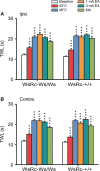Mast cell deficiency attenuates acupuncture analgesia for mechanical pain using c-kit gene mutant rats
- PMID: 29551908
- PMCID: PMC5842768
- DOI: 10.2147/JPR.S152015
Mast cell deficiency attenuates acupuncture analgesia for mechanical pain using c-kit gene mutant rats
Abstract
Background: Acupuncture therapy plays a pivotal role in pain relief, and increasing evidence demonstrates that mast cells (MCs) may mediate acupuncture analgesia. The present study aims to investigate the role of MCs in acupuncture analgesia using c-kit gene mutant-induced MC-deficient rats.
Materials and methods: WsRC-Ws/Ws rats and their wild-type (WT) littermates (WsRC-+/+) were used. The number of MCs in skin of ST36 area was compared in two rats after immunofluorescence labeling. Mechanical withdrawal latency (MWL), mechanical withdrawal threshold (MWT), and thermal withdrawal latency (TWL) were measured on bilateral plantar for pain threshold evaluation before and after each stimulus. Acupuncture- and moxibustion-like stimuli (43°C, 46°C heat, 1 mA electroacupuncture [EA], 3 mA EA, and manual acupuncture [MA]) were applied randomly on different days.
Results: Fewer MCs were observed in the skin of ST36 in mutant rats compared to WT rats (P<0.001). For pain thresholds, MWL and MWT were higher in WsRC-Ws/Ws compared to WsRC-+/+ on bilateral paws (P<0.05), but TWL was not different between the two rats (P>0.05). Bilateral MWL and MWT in WsRC-+/+ rats increased significantly after each stimulus compared to baseline (P<0.01, P<0.001). In WsRC-Ws/Ws rats, only noxious stimuli could produce anti-nociceptive effects for mechanical pain (46°C, 3 mA EA, MA) (P<0.01, P<0.001). Additionally, the net increases in MWL and MWT induced by most stimuli were greater in WT than in mutant rats (P<0.05). For thermal nociception, either high- or low-intensity stimuli could significantly augment TWL in two rats (P<0.001), and the net increases of TWL evoked by most stimuli were to the same extent in two genetic variants.
Conclusion: MCs influence the basic mechanical but not thermal pain threshold. MCs participate in acupuncture analgesia in mechanical but not in thermal nociception, in that MC deficiency may attenuate the mechanical analgesia evoked by high-intensity stimuli and eliminate analgesia provoked by low-intensity stimuli.
Keywords: WsRC-Ws/Ws rats; mechanical withdrawal threshold; stimulus intensity; thermal withdrawal latency; tryptase.
Conflict of interest statement
Disclosure The authors report no conflicts of interest in this work.
Figures






Similar articles
-
[Effects of electroacupuncture and regional thermal stimulation at "Zusanli" (ST 36) on pain thresholds of TRPV 1 knock-out mice].Zhen Ci Yan Jiu. 2012 Dec;37(6):431-9. Zhen Ci Yan Jiu. 2012. PMID: 23383450 Chinese.
-
[Effects of acupoint-nerve block on mast cell activity, manual acupuncture- and electroacupuncture-induced analgesia in adjuvant arthritis rats].Zhen Ci Yan Jiu. 2009 Feb;34(1):31-5, 56. Zhen Ci Yan Jiu. 2009. PMID: 19526805 Chinese.
-
[Relationship between the function of mast cells and acupuncture analgesia in adjuvant arthritis rats].Zhen Ci Yan Jiu. 2007 Feb;32(1):16-9. Zhen Ci Yan Jiu. 2007. PMID: 17580434 Chinese.
-
The Role of Skin Mast Cells in Acupuncture Induced Analgesia in Animals: A Preclinical Systematic Review and Meta-analysis.J Pain. 2021 Dec;22(12):1560-1577. doi: 10.1016/j.jpain.2021.06.006. Epub 2021 Jun 25. J Pain. 2021. PMID: 34182104
-
[The modulation of cerebral cortex and subcortical nuclei on NRM and their role in acupuncture analgesia].Zhen Ci Yan Jiu. 1996;21(1):4-11. Zhen Ci Yan Jiu. 1996. PMID: 9387347 Review. Chinese.
Cited by
-
Increasing Efficiency of Repetitive Electroacupuncture on Purine- and Acid-Induced Pain During a Three-Week Treatment Schedule.Front Pharmacol. 2021 May 10;12:680198. doi: 10.3389/fphar.2021.680198. eCollection 2021. Front Pharmacol. 2021. PMID: 34040538 Free PMC article.
-
Transcutaneous electrical acupoint stimulation combined with electroacupuncture for rapid recovery of patients after laparotomy for gastrointestinal surgery: a study protocol for a randomised controlled trial.BMJ Open. 2021 Nov 2;11(11):e053309. doi: 10.1136/bmjopen-2021-053309. BMJ Open. 2021. PMID: 34728456 Free PMC article.
-
Purinergic signaling as a basis of acupuncture-induced analgesia.Purinergic Signal. 2020 Sep;16(3):297-304. doi: 10.1007/s11302-020-09708-z. Epub 2020 Jun 23. Purinergic Signal. 2020. PMID: 32577957 Free PMC article. Review.
-
Song's Mast Cell Theory of Acupuncture.Med Acupunct. 2022 Oct 1;34(5):316-324. doi: 10.1089/acu.2022.0035. Epub 2022 Oct 17. Med Acupunct. 2022. PMID: 36304257 Free PMC article.
-
Mast Cells and Acupuncture Analgesia.Cells. 2022 Mar 2;11(5):860. doi: 10.3390/cells11050860. Cells. 2022. PMID: 35269483 Free PMC article. Review.
References
-
- Ernst E. Acupuncture therapy for neurological diseases. Focus on Altern Complement Ther. 2015;15(4):339–339.
-
- Lu CY, Huang HC, Chang HH, et al. Acupuncture therapy and incidence of depression after stroke. Stroke. 2017;48(6):1682. - PubMed
-
- Radwan AM. Acupuncture and pain. Pain. 1984;18(Suppl 1):S151.
-
- Han Z, Jiang YH, Wan Y, Wang Y, Chang JK, Han JS. Endomorphin-1 mediates 2 Hz but not 100 Hz electroacupuncture analgesia in the rat. Neurosci Lett. 1999;274(2):75–78. - PubMed
LinkOut - more resources
Full Text Sources
Other Literature Sources

